This book is a collection of photographs illustrating the different variants of what were commonly known as High Speed Trains, or HSTs.
Published in October 2023 by Amberley Publishing and written by George Woods this soft cover book measures around 23.4 cm x 16.5 cm, has 96 pages and 180 illustrations, and has a published price of £15.99, but at the time of writing it can be purchased for £14.39 from Amberley Publishing and for £12.29 from Amazon.
Since the mid-1970s the Class 43 High-Speed Trains have been a familiar sight on Britain’s railways, followed later by their Class 180 and Class 220/221/222 Voyager and Meridian variants, all of which have a maximum speed of 125 mph. It is these classes of trains that are the subjects of the book, but as nearly all diesel trains are now capable of 100 mph, which qualifies them as an express diesel train, the title is a little misleading. The book also includes a short coverage of the latest Azuma trains.
A three-page Introduction provides a background to the introduction of the Class 43s, and is followed by 72 pages of photographs illustrating them at work throughout the length and breadth of the country for different operators and in various liveries. Well-written captions show relevant details about the locomotives, their work, location, and date. These are followed by 15 pages illustrating Voyagers in Virgin and Cross Country liveries, and six pages of Class 180s in First Great Western, Hull Trains, and Grand Central liveries. The book concludes with four photographs of Class 222s in Midland Main Line and East Midlands Railway liveries, and three photographs of Class 800 Azumas.
Each caption provides sufficient details to be useful, including details of the train, location, and date and, where relevant, some useful additional information.
The author’s photographic skills show up well in the range of subjects included and are well complemented by good reproduction at the print stage.
Before the advent of franchising, the Class 43 HSTs carried the British Rail double-arrow logo and the title “InterCity 125”, as seen on the units below at and near York.
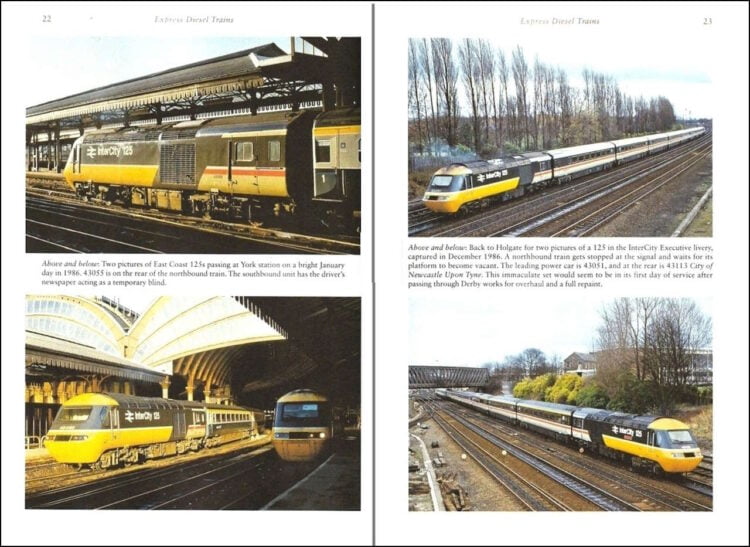
For some strange reason, while most pages in the book have two photos per page, some of them have a larger illustration but rotated to fit the page. It would have been preferable to retain the two-per-page format throughout. The unit at the left varies from the previous units in having lost its double-arrow logo and the “125” after InterCity, which is now all in capitals.
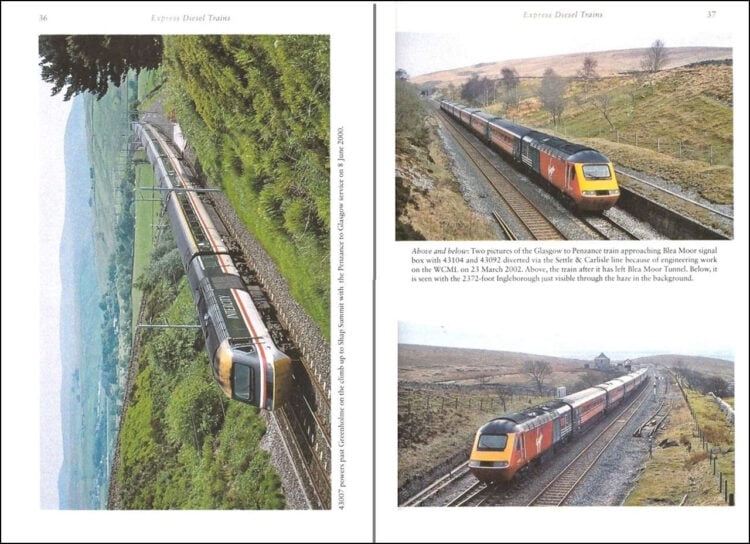
The pages below provide a good comparison of the benefit of retaining the two photos per page format throughout. The photos on the left also highlight the variations in colour schemes adopted by First Great Western.
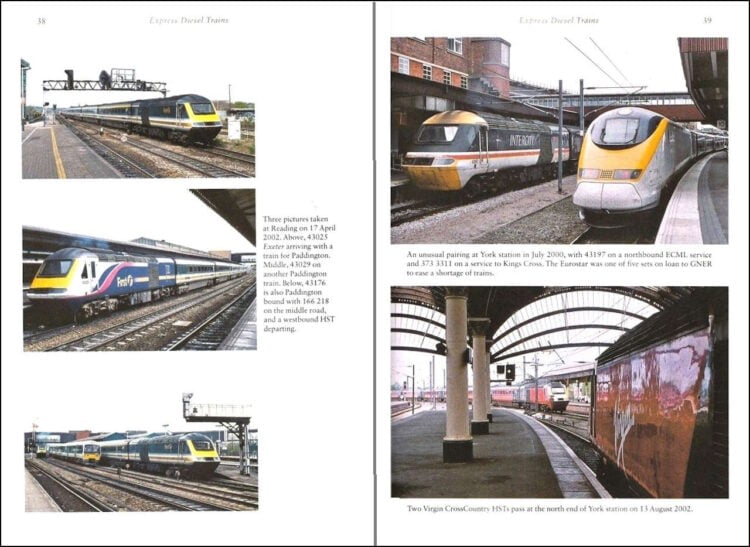
For many years the former Western Region was the exclusive preserve of Class 180s, but as seen below they were later used on East Coast Main Line and Northern services. An immediate difference in appearance to the Class 43s is the split windscreen. As in the previous example, the use of three photos per page format does not enhance their clarity.
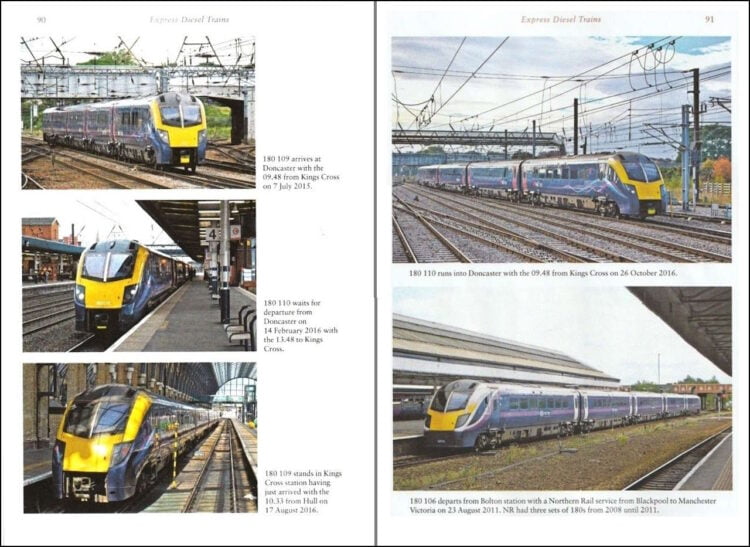
The pages below show the only examples in the book of the Class 222 Meridians used on the Midland Main Line, as well as two of the latest Azumas at the bottom right. With so few examples of these classes included, it would have been better to ensure that they were presented in a two-per-page format.
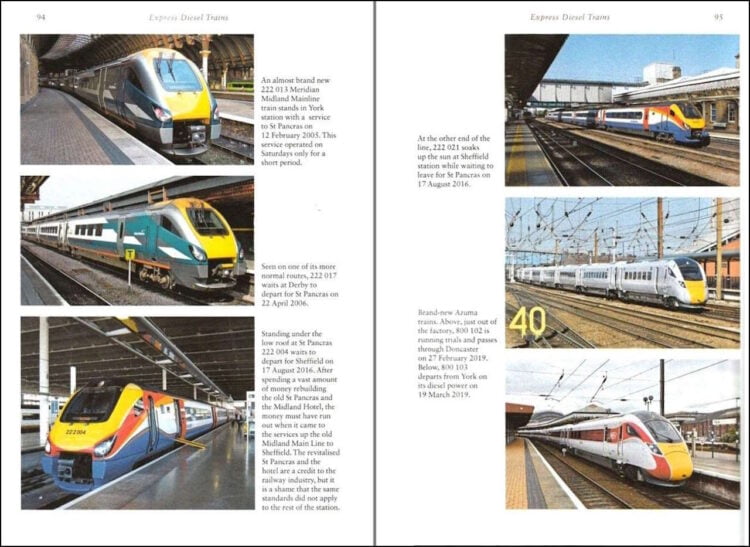
Although the book’s title is Express Diesel Trains, the book limits its coverage to the Class 43, Class 180, and Class 220/221 Voyagers, with the Class 222 Meridian variants included almost as an afterthought, as well as a brief mention of the latest Azumas. When the Class 43s were introduced they were the only diesel trains that could be considered Express Diesel Trains, but nearly all diesel trains are now capable of 100 mph, which should qualify them for inclusion in this book.
There were many more Class 43s than the Class 180s, Class 220/221 Voyagers, and Class 222 Meridian, and their use was far more widespread, which accounts for the unbalanced examples shown for each class. The author has included a good selection of the different liveries covered by each class, even including a Network Rail version on its Network Measurement Train.
Without exception all photographs are well composed with well-written captions, and given the limited number of classes, the final selection is well balanced.
As is usual with books from this publisher, it would have been useful to provide a detailed index.
The book is available to purchase from Amazon and from Amberley Publishing.
We would like to thank Amberley Publishing for providing us with a copy of the book for review.






Responses